The 8 Best Words to Use in Your Next Email

There’s a simple way to transform your email copy from passable to powerful — choose the right words. Effective words will inspire your subscribers to open, click, and buy.
Choosing the wrong words in your next email, on the other hand, could damage your email engagement and even annoy or insult your audience. By learning a few key tips, you can avoid these common mistakes and write emails your subscribers will love.
In this article we’ll talk about:
- 8 power words for effective emails
- How to begin & end emails
- Wording for complicated situations
- Phrases to unlearn and replace
8 Power Words for effective emails
These 8 everyday words can have a huge impact on your email engagement. (Spoiler: We just used one of them.)
You might be surprised. Some of the most effective words are ones you use everyday. The words are:
- Now
- You/Your
- Thanks
- New
- Easy
- And
- Free
- [Insert name here]
Now, find out why these words are so effective and how to use them.
Related: How to Craft Irresistible Newsletter Content
1. Now
The word “now” is one of the most effective words to use in email, because it invokes action and urgency. It asks subscribers to do something right away, rather than putting it off until later.
“Now” is a good word to use in your subject line to increase open rates. Or, include it in your call-to-action (CTA) button to increase click-through rates.
However, when using this word in your emails, you want to make sure that subscribers understand what action they need to take. The next step should be clear since you’re asking them to do something immediately. You can achieve this by making your email focused on one specific outcome with one CTA, a top trend in B2B emails in 2017.
Related: Download AWeber's Email Marketing Statistics Report to learn more about calls to action (CTAs), writing effective emails, and email benchmarks.
Rifle Paper Co. utilizes the word “now” by incorporating it in the CTA button and focusing the email on one outcome: shopping for planners.
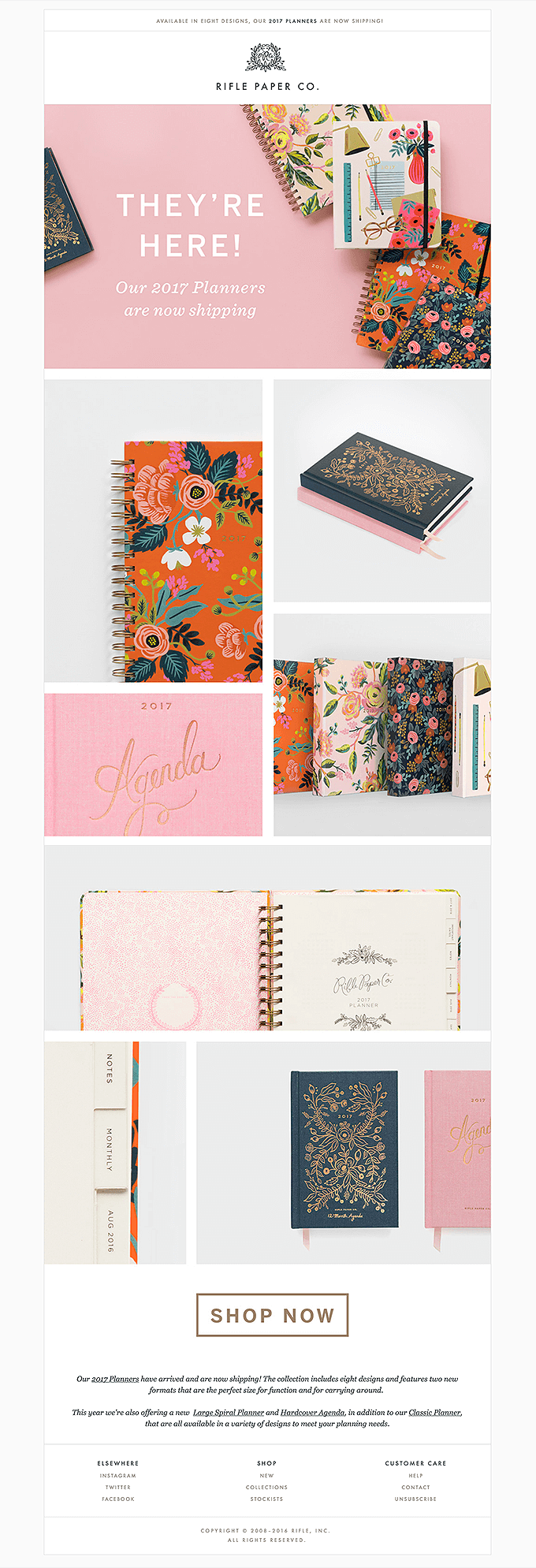
2. You/your
You can also make your emails more compelling by using the words “you” or “your” instead of speaking in the third person.
“You” and “your” are effective because they give your message a personal feel. This viewpoint can make your subscriber feel like you’re speaking to them exclusively, rather than a group of people. We use second person in our emails, blog posts, and ad copy. (It’s even in this blog post’s title!)
This email from Sky Sports incorporates “you” and “your” to get subscribers excited for their own summer of sport. The email does a really great job of letting subscribers visualize the impact in their own lives.

3. Thanks
Thanking your subscribers is more important than you think. Not only does it add a human quality to your email, but it also builds brand loyalty. When subscribers know you appreciate them, they are more likely to have positive feelings toward you and your brand.
Then, when they are ready to make a purchase, they may not remember why they like you, but they know you made them feel good at some point in the relationship.
Not sure how to thank subscribers through email? Here’s an idea: Send an email celebrating the anniversary of when they subscribed to your list. You can take this opportunity to thank them while also reminding them of their long-term loyalty.
And there’s an easy way to do this with email automation! Just add your anniversary email to your follow-up series for 365 days after the first message.
Here’s a great example of how Harry’s said thank you in an anniversary email.
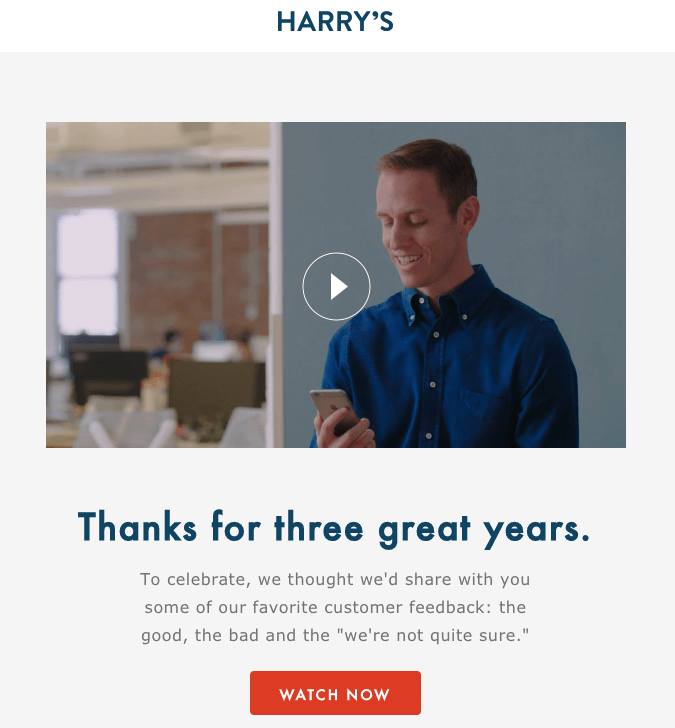
4. New
The word “new” is a great word to give subscribers that extra push to download your content or buy your product. To subscribers, “new” can signify that the content offered in the email is fresh, and they have the opportunity to get it before others.
It may also guarantee that the content was created with the most recent information. For example, if you are offering a download of a new industry report, subscribers want to know that the information found inside is up-to-date.
“New” works especially well for sales emails when you are introducing a recent product that has just been released because it invokes excitement! Who doesn’t love something brand new and shiny?
5. Easy
Using the word “easy” in an email emphasizes to subscribers that what you’re asking is not difficult.
Also, if you’re speaking to a beginner audience, it can alleviate worries about not being able to complete the task.
For example, let’s imagine that you are a personal trainer and your audience doesn’t know how to get started with weightlifting. To make them feel more confident, you can assure them that your services or content make it easy to get started and begin seeing results.
Check out this example email from Uber, which informs new customers that using the app is easy:
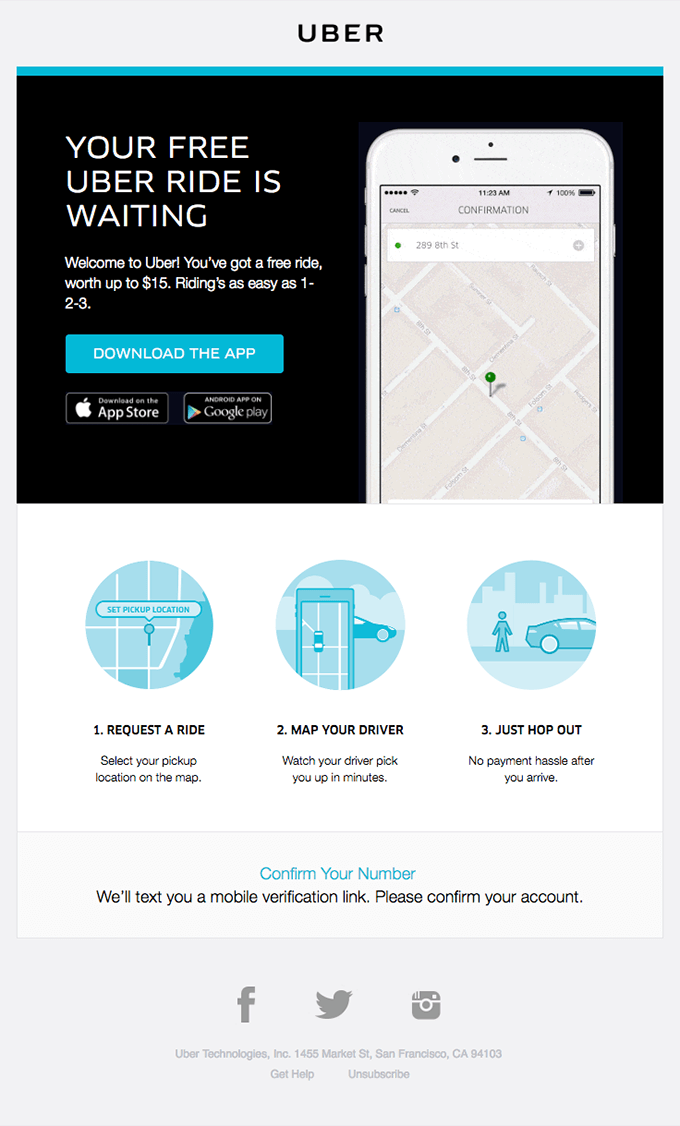
6. And
Try this in your next content offer email: phrase the offer in a way that makes subscribers think they’re getting a great deal by using “and.”
Even when you have nothing else to give (or time to create more content), restructure the way you promote it to make it sound like a great deal!
For example, we offer a guide called “What to Write in Your Emails” and when we promote this guide we often call it the “What to Write guide and 45+ email content templates.” The templates are a part of the guide, but by using “and,” we phrase it in a way that adds more value to the guide.
Applying this principle, we sent out an email offering free content when subscribers signed up for an AWeber account. The email bundled two pieces of content using “and” to maximize the value of our offer:
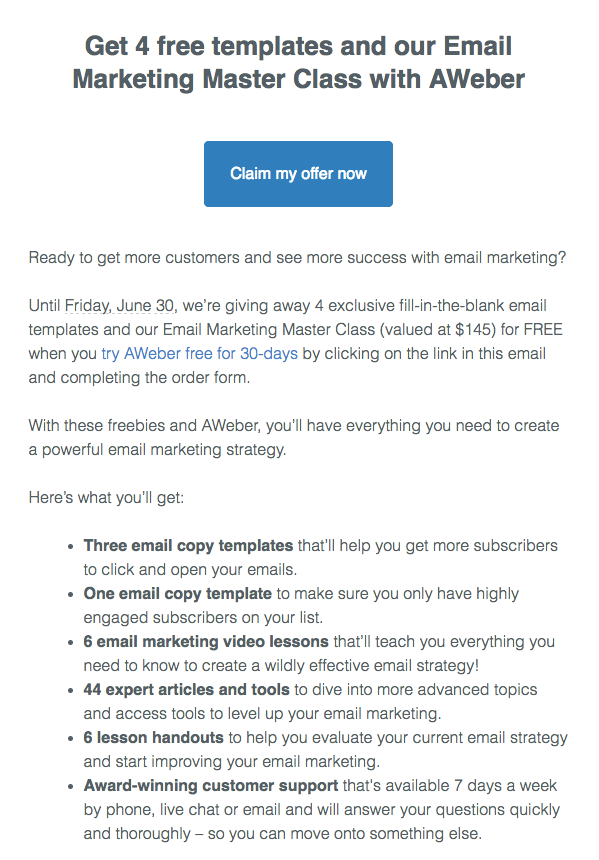
7. Free
“Free” is one of the most persuasive words in the English language, and for good reason. Because who doesn’t love free stuff?
It can get subscribers to take action, because there is no risk involved.
It can also signal that the subscriber is saving money. For example, online retailers use this effectively when they offer free shipping on purchases.
8. [Insert name here]
Personalization is key in your emails. Not only does it help you connect with subscribers, but it also catches attention in the inbox and in the email itself.
Consumer behavior research shows that when we hear our own name, it signals that important information will be directed at us. After all, it’s the first word we learn to read and write – even dogs and cats recognize their own name being called.
Adding a subscriber’s name to an email can earn more engagement and trust from the subscriber reading the message.
The email below from Simple uses the subscriber’s name in the headline to immediately catch his attention.
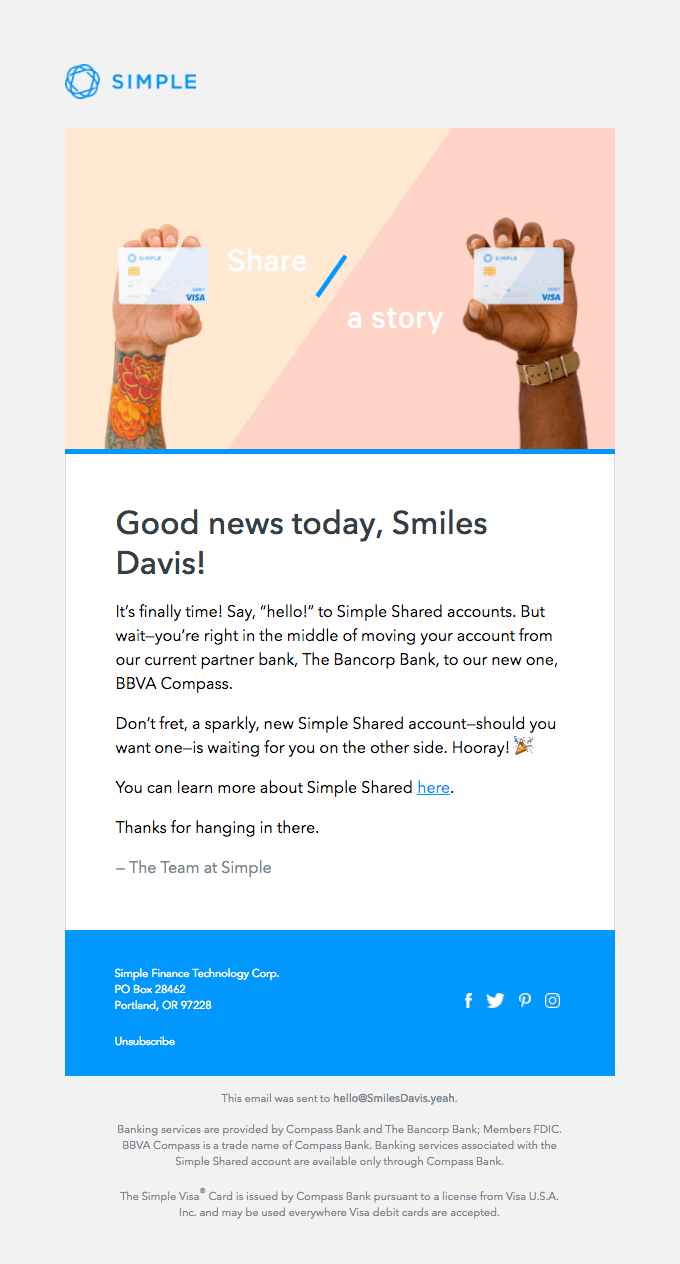
Words to start and end emails
Using the wrong words or tone at the beginning of your email is a great way to lose subscribers’ interest. You’ve probably received an email with an overly formal and impersonal “To Whom It May Concern,” or a too enthusiastic and unprofessional “Hey!!!!!”
And then there’s the awkward email endings. For example, a business ends an email with no signoff, or concludes an email with a mile-long signature, complete with an irrelevant, “inspirational” quote.
If you find yourself overthinking and unsure how to handle either your email intro or conclusion, here are a few tips to help you know how to say “hello” and “goodbye” in any professional email.
How to begin an email
When to say “Hello,” “Hi,” and “Hey”: These are written in order of formality, with “Hello” being most formal. If you’ve never met in person before and are writing for the first time, use “Hello [Name].” Once you’re more familiar, you can move on to “Hi [Name].” “Hey” is reserved for when you’ve established a rapport with the person.
When you’re unsure of their name: Say: “Hello there,” or simply: “Hello.” There’s no need to say: “To Whom It May Concern,” especially if the rest of your email doesn’t match this formal tone. When emailing a group of subscribers, instead of using “Hello,” you could try using an informal and fun greeting, like Ann Handley does in her newsletter TotalAnnarchy.
IMAGE
When you’re addressing a group: Say a variation of: “Hello everyone” or “Hi Team.” Keep it gender neutral and avoid saying phrases like, “Ladies and gentlemen.” If you’re sending an email marketing message to a group of subscribers, you should write as if you’re talking directly to one person. In this scenario, you could use “Hello” or even “Hello friend.”
When they have a title: If you’ve received an email from someone and their signature includes a title, you should always respond with this title. If you’re unsure of their title, it’s always best to do a bit of research ahead of time. Never address someone with a PhD as Mr. or Ms.
How to end an email
When to use which words: Think about the purpose of your email, and the kind of response you’re requesting to help you determine your signoff.
- Best: A friendly signoff that doesn’t suggest familiarity.
- Regards: This word is useful in a professional setting. You can soften it with “Kind regards” or “Warm regards.”.
- Thank you: This is the most appropriate closing if you’re asking the recipient for a task or favor, or genuinely thanking them for something.
- Sincerely - Use this only if your email is used in the place of a traditional letter.
What to include in our signatures: Most of us set up a signature to automatically populate at the bottom of our emails. Keep it simple to make sure it’s an appropriate signature in all situations. Include your full name, your professional title, and preferred contact methods. You can even include your headshot to add personality and a face to your name, like we do in the email below.
IMAGE
When to drop the signature: It’s a best practice to sign off your emails with a closing, even if your email chain has been going on for a while.
In the case of email marketing messages to a group of subscribers, you should include a signature if your email sender name is an individual’s name or an individual is sending the email.
Using words carefully
When in person, you can soften difficult conversations with your tone, face, gestures, and other body language. These subtle shifts are nearly impossible to mimic via email. When words are our only tool, here are some tried-and-true phrasings to help convey common awkward messages.
Sending emails during a crisis: In unprecedented times, there’s no one-size-fits-all manual for how to send emails to your email subscribers.
However, many learned during the COVID-19 pandemic that there *are* right and wrong ways to do it. Recipients can tell the difference between a genuine email and a company taking advantage of a crisis. Keep your messaging simple, your tone serious, and focus on the changes you’re making. We actually wrote an entire post about email marketing during a pandemic like COVID-19.
Asking for a quick reply: By using certain words, you can shift focus from the urgency of the situation to your appreciation. For example, “I would appreciate a reply at your earliest convenience.” Or provide a hard deadline: “To meet our deadline, kindly send me your thoughts by 5 p.m.”
Following up after no response: Most emails are opened the day they arrive. So sending a gentle reminder not long after sending your first email (around 2 to 3 days later) is a good way to gauge whether your recipient simply forgot, or they have no interest in responding quickly. For this email, you can keep it straight to the point, with a clear call to action: I am following up to see what you think about [issue].
For email marketing messages, you can easily send a follow up email to subscribers who didn’t open your first email. You can even send an email to subscribers who didn’t click on the call to action in your first email.
Common email mistakes and words to use instead
Sometimes politeness can be misinterpreted as passiveness, uncertainty, or a lack of confidence. Skirting around the issue of what you really want can just cause more emails, wasted time, and misunderstandings. It’s best to just simply say what you mean and ask for what you want. Here are some common mistakes and ways to correct them by rephrasing your statements:
Instead of: “Just checking in,” say “Let me know when you have an update.”
Instead of: “Sorry, I thought I mentioned that ...,” say “As I said, …”
Instead of: “I was wondering if ...,” say “It would be best to …”
Instead of: “What time works best for you?,” say “Can you meet between 3 and 5 p.m. ?”
Instead of: “Sorry for the late reply,” say “Thank you for your patience.”
Instead of: “Sorry I didn’t see that!,” say “Nice catch! Thank you. It’s updated now.”
Instead of: “I think we should …,” say “Based on my experience, we should …”
Overall tips
If you can’t fit the 8 power words or the email phrases from this post in your emails in a logical way, use the principles behind these words to brainstorm your own! Here are some guidelines to help you apply these principles to your own emails:
- Keep it short. Use short words in your emails because they’re easier for your audience to read quickly.
- Make it easy to understand. Avoid complex words and make it easy for your audience to understand your email.
- Be specific. Using specific language will bring your emails to life and make your content more interesting for your email subscribers, colleagues, and clients — especially when you only have a few seconds to get their attention and make an impact.
Want more help?
If you’re stuck on how to effectively use these words in your emails or you just don’t have time to write your emails, try the What to Write guide. It includes 45+ email content templates, already loaded with the most effective words to use in your messaging.
Additional reporting by Shelby McGuigan. Updated on 6/2/2020.
The post The 8 Best Words to Use in Your Next Email appeared first on Email Marketing Tips.
from Email Marketing Tips https://ift.tt/2u8YvDn
via

No comments